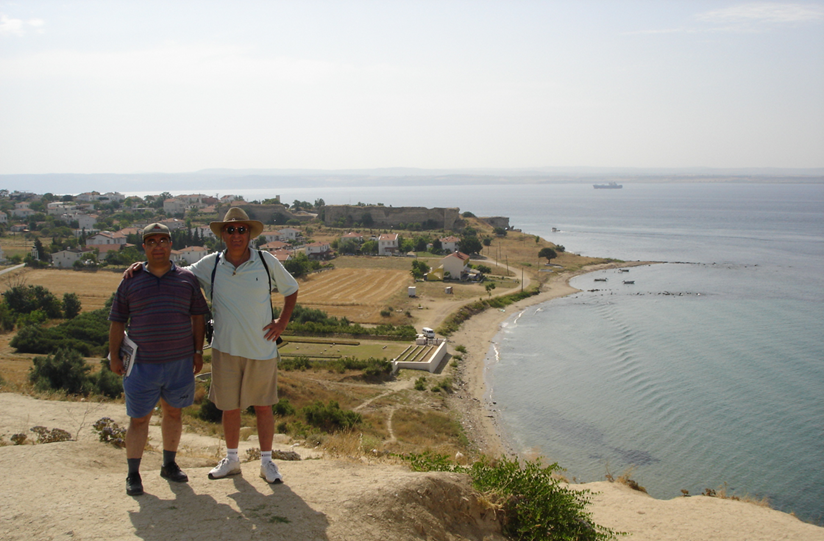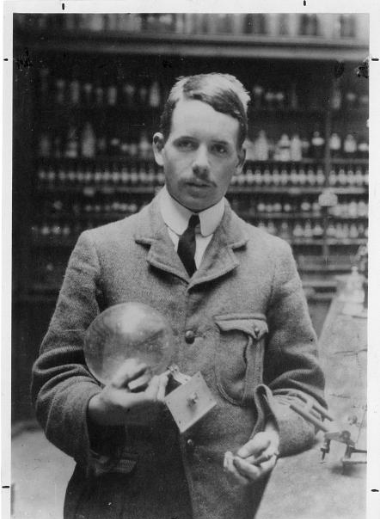Taking Measure
Just a Standard Blog
Henry Moseley: A Patriotic Scientist Who Changed the Periodic Table — and Then Went Off to War

Henry Moseley established the concept of the atomic number and helped scientists first understand the structure of the atom.
Physicist Henry Moseley did not have to fight for his country in World War I.
Because he was an aristocrat and an accomplished scientist, the young Moseley’s mother told him he could serve his country using his scientific expertise from behind the battle lines.
Undaunted, Moseley tried to join the British military’s Royal Engineers but was initially rejected. They told Moseley, “We need engineers, not physicists.”
Nevertheless, he eventually joined them as the second lieutenant, leading a command of 26 soldiers.
A few months later, during the early morning of Aug. 10, 1915, about 1,000 British soldiers were killed in a bloody battle at the Gallipoli peninsula in the Ottoman Empire (present-day Turkey). The invasion of Gallipoli was a disaster for Britain and its allies.
Among those killed was Moseley, who was shot in the head and died instantly. He was 27, about three months short of his 28th birthday.
But even at a young age, Moseley had already made a lasting impact on science with his contributions to the periodic table of the elements.
I became aware of Moseley’s death at the battle of Gallipoli when I was reading Richard Rhodes’ book The Making of the Atomic Bomb in 2008. The book had a picture of Moseley in his military uniform.
I became very interested in finding out more about Moseley’s death, his scientific contributions and how he ended up being in the middle of this war. I had always been interested in the history of the battle of Gallipoli and had previously visited the battlefields four times.

My fascination with this battle is an intersection of where I am from and what I do. I’m originally from Turkey and a scientist. My work and the work of many scientists depends on the periodic table, so it’s important for us to remember the work of those who contributed to it — especially today on Periodic Table Day.
I’ve been fortunate to visit Gallipoli multiple times; it’s a beautiful and serene place. Some of the British soldiers who survived Gallipoli wrote in their memoirs that they could hear the nightingales singing at night.
I’ve had the opportunity to give talks about Moseley in a friendship meeting between the Turkish and British organizations dedicated to the remembrance of this battle, as well as to several universities in Turkey. I even wrote a small book about Moseley at the request of the Turkish Academy of Sciences, where I had given a talk about him.
Gallipoli was a turning point in Turkish history because Colonel Mustafa Kemal (Atatürk), who led the Turkish soldiers to victory in that battle and others, went on to be the founder of the secular Republic of Turkey. He was also Turkey’s first president.
In 1934, Mustafa Kemal (Atatürk) honored all foreign soldiers fallen in Gallipoli with a memorial. In a written speech that was later carved into a stone memorial, he said:
“Those heroes who shed their blood and lost their lives. You are now lying in the soil of a friendly country. Therefore, rest in peace. There is no difference between the Johnnies and the Mehmets to us where they lie side by side now in this country of ours. You, the mothers, who sent their sons from faraway countries wipe away your tears; your sons are now lying in our bosom and are in peace. After having lost their lives on this land they have become our sons as well.”

After the war, the British returned to the Gallipoli peninsula and buried the bones of the soldiers who’d died there. Most could not be identified.
It’s very likely Moseley is buried there with hundreds of other unidentified soldiers. The fallen British soldiers’ names are carved in stone around the Helles Memorial built by the British in the peninsula. One of those is the name of the Second Lieutenant Henry Gwyn Jeffreys Moseley, Royal Engineers.
Moseley’s Early Life and Education
Henry Gwyn Jeffreys Moseley was born on Nov. 23, 1887, in Weymouth, England. He came from a rich and aristocratic family that included famous scientists. His father, Henry Nottidge Moseley, was a professor of anatomy and physiology at the University of Oxford. Henry was only 4 years old when his father died in 1891. His mother was Amabel Gwyn Jeffreys, the daughter of the Welsh biologist John Gwyn Jeffreys.
Moseley earned his bachelor’s degree in 1910 from Trinity College at the University of Oxford. Moseley then went to study under Professor Ernest Rutherford at the University of Manchester. Rutherford had received the Nobel Prize in Chemistry in 1908. His lab was a kind of “nursery of genius.” Rutherford employed young scientists from different countries who laid the foundations of much of modern atomic physics. Many of them received their own Nobel Prizes.
While working with Rutherford, Moseley became interested in the nature of X-rays, which had been discovered in 1895. Moseley was convinced that the discovery of unique X-ray wavelengths of every known element would offer science a powerful tool of chemical analysis. He believed it could shed light on the secrets of the atom’s structure. Moseley turned out to be right.
The Periodic Table of the Elements and Moseley’s Contributions
Today, we know the periodic table is a chart that represents all the chemical building blocks of matter. Each of these 118 blocks is known as a chemical element. Each element has an atomic number that’s equal to the number of protons in the atom’s nucleus.

During the time of Moseley’s research, however, there was a periodic table with only 63 elements. Russian chemist Dmitri Mendeleev established this version in 1869. At that time, the elements were arranged by the weight of their atoms, known as atomic weight.
However, in 1869, the concept of the atomic number existed, but it was arbitrary. It was merely an element’s place in the periodic table. Atomic number was not known to be associated with any measurable physical quantity. Chemists had already discovered that, in three places in Mendeleev’s table, the chemical order inverted the sequence of the atomic weights. There was no satisfactory explanation for this phenomenon.
In 1913, a hypothesis was put forward that the elements were arranged incorrectly in the table.
So, Moseley built an X-ray apparatus and used it to analyze the properties of 12 elements to test this hypothesis. Later, he extended this work and used the elements from aluminum to gold. He published his results in three papers, which established the equations between the frequency of the elements’ X-ray spectra and the atomic number. By measuring X-ray frequencies, Moseley gave scientists the measurable physical characteristic needed to more accurately arrange the periodic table.

These equations are known as Moseley’s Law. In one of the graphs in his last paper showing the relationship between the X-ray frequencies and the atomic numbers of the elements, Moseley left four vacant lines, predicting four unknown elements. After his death, these elements were discovered by other scientists.
Moseley’s work established the atomic number as the number of protons in the atomic nucleus.
Spectroscopy is the study of the absorption and emission of light, and Moseley laid the groundwork for using X-ray spectroscopy as a powerful tool of chemical analysis.
Moseley's work is beautifully summarized on a plaque on Oxford University’s Clarendon Laboratory:
“Clarendon Laboratory, where H.G.J. Moseley (1887-1915) completed his pioneering studies on the frequencies of X-rays emitted from the elements. His work established the concept of atomic number and helped reveal the structure of the atom. He predicted several new elements and laid the ground for a major tool in the chemical analysis.”
Moseley’s Legacy
When the news of Moseley’s death reached Manchester, Rutherford was deeply shocked and wrote, “Moseley was one of the best of the young people I ever had, and his death is a severe loss to science.”
Many in the science community criticized Britain’s use of brilliant scientific minds for combat, since other scientists also died in battle.
Rutherford wrote in a letter to Nature, “It is a national tragedy that our military organization at the start was so inelastic as to be unable, with a few exceptions, to utilize the offers of services of our scientific men except as combatants on the firing line. The loss of this young man on the battlefield is striking example of the misuse of scientific talent.”
The lesson was learned to some extent during World War II. In that war, the British military organization assigned scientists to behind-the-lines work.
Additionally, after the disasters at the battles of Gallipoli, the battle’s architect — Winston Churchill — lost his job as First Lord of the Admiralty.
Both the U.S. and British navies, however, learned lessons from Gallipoli and applied those during the assaults in Normandy on D-Day, June 6, 1944, in World War II. Moreover, the Gallipoli campaign fostered the national identity in Australia and New Zealand, and both countries emerged as independent states.
As far as Moseley’s scientific legacy, he published eight papers in his short life. Moseley led to great advances in physics and chemistry. Other scientists, who made important discoveries during the same period, were awarded with the Nobel Prize.
Many of Moseley’s colleagues said that if he had lived, Moseley would have received the Nobel Prize in a few years. In fact, Karl Manne Siegbahn, the researcher who followed Moseley’s planned work and technique after his death, won the Nobel Prize in Physics in 1924.
For a researcher at such a young age to change the periodic table — one of the most fundamental things we use in physics and chemistry — I often wonder what else he could’ve done if Moseley had survived Gallipoli. We’ll never know, but I’m pleased to play a small part in making sure he’s remembered on Periodic Table Day and every day.
Editor’s Note: Learn more about Henry Moseley’s life and legacy on our Material Measurement Laboratory page. The author used the following sources for information for this blog post:
- Henry G.J. Moseley and Charles G. Darwin, The Reflexion of the X-Rays, Phil. Mag. 26, 210-232, 1913.
- Henry G.J. Moseley, The High-Frequency Spectra of the Elements, Phil. Mag. 26, 1024-1034, 1913.
- Henry G.J. Moseley, The High-Frequency Spectra of the Elements, Part II, Phil. Mag. 27, 703-713, 1914.
- Bernard Jaffe, Moseley and the Numbering of the Elements, Anchor Books, Doubleday & Company Inc., New York, 1971.
- Isaac Asimov, Asimov’s Biographical Encyclopedia of Science and Technology, Anchor Books, Doubleday & Company Inc., New York, 1972.
- John L. Heilbron, H.G.J. Moseley: The Life and Letters of an English Physicist, 1887-1915, University of California Press, Berkeley and Los Angeles, California, 1974.
- John L. Heilbron, Historical Studies in the Theory of Atomic Structure, Arno Press, New York, 1981.
- Richard Rhodes, The Making of the Atomic Bomb, Simon & Schuster, New York, 1986.
- Eric R. Scerri, The Periodic Table, Its Story and Significance, Oxford University Press, Oxford, 2007.
More Taking Measure Posts About Historical Figures in Science






this was very interesting and helpful thank you.